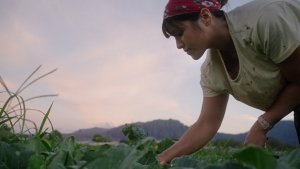A deep-seated gut instinct urged Kahealani Acosta to leave her roots in San Jose and attend the University of Hawaiʻi at Mānoa. Acosta, who is part Native Hawaiian, had never stepped foot in the birthplace of her kūpuna (elders) and yearned to learn about her Indigenous lineage.
“It was a feeling in my naʻau (gut instinct), I knew I was Hawaiian but didn’t know what that meant and I needed to know,” she explained. “I knew I needed to go and understand what that meant.”
Acosta is one of four students set to be featured in UH Mānoa’s “Finding Our Kuleana,” campaign, a collection of personal narratives that capture students who discover their purpose and sense of responsibility while pursuing college degrees.
- Read more about “Finding Our Kuleana”: Students discover, share kuleana at UH Mānoa, December 17, 2021
In 2013, Acosta began her path toward a bachelor’s degree in tropical plant and soil sciences (TPSS) at UH Mānoa’s College of Tropical Agriculture and Human Resources (CTAHR). Motivated by an interest in food nutrition, her academic journey helped her explore ways to heal our food systems by producing foods from Hawaiʻi through organic and regenerative practices.
“In Hawaiian, the word for land is ʻāina,” she explained. “And ʻāina is also the old word for ʻohana. When you’re eating food…it’s your ʻāina that’s sustaining you. It’s your family that’s sustaining you.”
Through CTAHR, Acosta discovered what she describes as a profound connection to ʻāina while working at MAʻO Organic Farms in Waiʻanae, one of the state’s largest certified organic farms that generates more than 40 varieties of fruits and vegetables. Through MAʻO’s Farm Expansion Experience, she accepted a position to help shape Leeward Oʻahu youth hungry for critical guidance transitioning into adulthood. Through ʻāina-based learning at MAʻO, Acosta intertwined life lessons for the students while navigating hands-on work on the farm, everything from tilling the soil to planting and harvesting crops at the sprawling parcel in Lualualei Valley.
“It was a fulfilling experience for me because I finally felt like I belonged and realized my story was no different from these youth,” said Acosta. “I wanted to show them that they have all the opportunities I have and they can transcend from stereotypical views and do what you love and are passionate about.”
Discovering parallels

At UH Mānoa, Acosta continues to strive alongside her mentors and is currently working on a master’s degree in TPSS and preparing a thesis based on breadfruit (ʻulu) nutrient deficiencies. The 28-year-old expressed a personal bout with a serious illness that led her to deeply connect with ʻulu. She explained the connection was an almost mystical bond, one that propelled her to seek solutions for debilitating ailments plaguing breadfruit.
“It just felt like the tree was trying to teach me a lesson about myself and I found out that the tree was trying to help me restore all of that hurt and illness I was going through,” Acosta said.
Her research focuses on how to best treat problems that may compromise the tree’s health. Acosta’s goal is to develop a manual for farmers to assist in helpful nutrient management techniques and provide access to more breadfruit resources.
“Kahealani’s journey exemplifies CTAHR’s educational mission, which is to provide the opportunity for our students to learn,” said CTAHR Dean Nicholas Comerford. “That means learning how to work together, how to evaluate issues, how to bring their knowledge to bear on solutions, and hopefully, how to communicate those solutions to our relevant communities.”
Acosta has also managed to delve into the innovation field, she combined her love of mālama ʻāina (caring for the land) and spearheaded the design and development of a board game. The educational game, ʻĀina Continuum, is Acosta’s startup launched during UH’s mentorship program, (K)new Futures Challenge. Guided by the UH Office of Indigenous Innovation, UH Office of Sustainability and UH Mānoa Native Hawaiian Place of Learning Advancement Office, the program helps to enhance student projects by drawing upon Hawaiian ancestral knowledge.
This campaign is an example of UH Mānoa’s goal of Becoming a Native Hawaiian Place of Learning (PDF), Enhancing Student Success (PDF), Excellence in Research: Advancing the Research and Creative Work Enterprise (PDF) and Building a Sustainable and Resilient Campus Environment: Within the Global Sustainability and Climate Resilience Movement (PDF) the four goals identified in the 2015–25 Strategic Plan (PDF), updated in December 2020.

